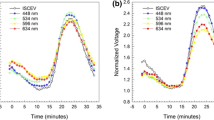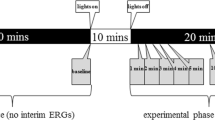Abstract
The influence of four different intensities of the preadapting light on amplitude and implicit time of the dark-induced oscillation (dark trough) of the electro-oculogram was tested in 10 healthy individuals. The amplitude of the dark trough (normalized to preadapting baseline) was found to be dependent on the intensity of the preadapting light (analysis of variance:p < 0.0001). No correlation could be proven between preadapting light intensity and the implicit time of the dark trough (p = 0.299). The confidence intervals of the implicit time of the dark trough exceeded 14 minutes in all four intensity settings. There was no significant dependence of the absolute baseline values on preadapting intensities (p = 0.236).
Similar content being viewed by others
References
François J, Verriest G, De Rouck R. Electro oculographie en tant qu'examen fonctionnel de la retine. Prog Ophthalmol 1957; 7: 1–67.
Arden GB, Barrada A, Kelsey JH. New clinical test of retinal function based upon the standing potential of the eye. Br J Ophthalmol 1962; 46: 449–61.
Arden GB, Barrada A. Analysis of the electro-oculograms of a series of normal subjects. Br J Ophthalmol 1962; 46: 468–82.
Gliem H. Das Elektrooculogramm. Abhandlungen aus dem Gebiete der Augenheilkunde, Band 40. Leipzig, Georg Thieme, 1971.
Täumer R, Mackensen G, Hartman H, et al. Verhalten des ‘Bestandpotentials’ des menschlichen Auges nach Belichtungsänderungen. Arch Klin Exp Ophthalmol 1974; 189: 81–97.
Weleber RG. Fast and slow oscillation of the electro-oculogram in Best's macular dystrophy and retinitis pigmentosa. Arch Ophthalmol 1989; 107: 530–7.
Ulbricht R. Die Bestimmung der mittleren räumlichen Lichtintensität durch nur eine Messung. ETZ 1900; 21: 595–7.
Ulbricht R. Das Kugelphotometer. 1920. In: Helwig HJ, Über praktische Erfahrungen der neuen Messmethode für die Ulbrichtsche Kugel. Das Licht 1935; 5: 33–4.
Kolder HEJ, Scarpetetti R. Registrierungen von Änderungen des Bestandspotentials des menschlichen Auges. Plügers Arch Ges Physiol 1958; 276: 295–8.
Lessel MR, Lahoda R, Thaler ARG, Heilig P. Registriereinrichtung zur Erfassung der langsamen Potentialänderungen des Auges aus dem Elektrookulogramm. Biomed Tech Biomed Eng 1982; 27: 108–10.
Thaler ARG, Lessel MR, Heilig P, Scheiber V. The fast oscillation of the electrooculogram. Influence of stimulus intensity and adaptation time on amplitude and peak latency. Ophthalmic Res 1982; 14: 210–4.
Lessel MR, Joskowicz G, Thaler ARG, Lahoda R. The fast oscillation of the standing potential of the eye. Doc Ophthalmol Proc Ser 1982; 31: 105–7.
Dixon WJ, Brown MB, et al. BMDP statistical software, Part 5R. Berkeley: University of California, 1985.
Gardner MJ, Altman DG. Statistics with confidence: Confidence intervals and statistical guidelines. London, Brit Med J Publ, 1990: 83.
Thaler A, Heilig P, Gordesch J. Light peak to dark trough ratio in clinical electrooculography: Its clinical importance Basel: Karger, 1976: 110–4.
Krüger CJ. Der Anteil zentraler und peripherer Netzhautbezirke an der langsamen Hellschwingung im Elektrookulogramm (EOG). Ber Dtsch Ophthalmol Ges 1981; 78: 741–9.
Kooijman AC. The homogeneity of the retinal illumination is restricted by some ERG lenses. Invest Ophthalmol Vis Sci 1986; 27: 372–7.
Thaler A, Heilig P. The steady state in EOG. Doc Ophthalmol Proc Ser 1974; 4: 211–6.
Author information
Authors and Affiliations
Rights and permissions
About this article
Cite this article
Lessel, M.R., Thaler, A., Scheiber, V. et al. The dark trough in clinical electro-oculography. Doc Ophthalmol 84, 31–38 (1993). https://doi.org/10.1007/BF01203280
Accepted:
Issue Date:
DOI: https://doi.org/10.1007/BF01203280




